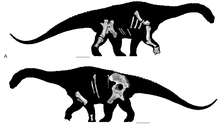- Diamantinasaurus
-
Diamantinasaurus
Temporal range: Early Cretaceous, 100 Ma
Scientific classification 
Kingdom: Animalia Phylum: Chordata Class: Reptilia Superorder: Dinosauria Order: Saurischia Suborder: †Sauropodomorpha Infraorder: †Sauropoda Branch: †Titanosauria clade: †Lithostrotia Family: †Antarctosauridae Genus: †Diamantinasaurus
Hocknull et al., 2009Species: †D. matildae
Hocknull et al., 2009Diamantinasaurus (meaning "Diamantina River lizard") is a genus of derived titanosaurian dinosaur from late Albian (Early Cretaceous)-age rocks of Australia. It is known from partial postcranial remains.
Description and history
Diamantinasaurus is based on AODL 603, a partial skeleton including a right shoulder blade, a sternal plate, much of the forelimbs, much of the hindlimbs except the feet, partial hips, and ribs. Diamantinasaurus was unusual for a derived titanosaurian in retaining a thumb claw. The limb bones were stout. Diamantinasaurus was described in 2009 by Scott Hocknull and colleagues. The type species is D. matildae, in reference to the folk song "Waltzing Matilda", which was written by Banjo Paterson in nearby Winton. A phylogenetic analysis found Diamantinasaurus to be a lithostrotian titanosaurian sauropod, in the same clade as sauropods such as Opisthocoelicaudia and Saltasaurus.[1] The discovery has been nicknamed "Matilda" after "Waltzing Matilda", and is described as a stocky herbivore about 52 feet (16 m) in length.[2][3]
Many titanosaurids are known to have had small armor plates, however, it is not known whether Diamantinasaurus had them.
Paleobiology
AODL 603 was found about 60 kilometres (37 mi) northwest of Winton, near Elderslie Station. It was recovered from the lower part of the Winton Formation, dated to the latest Albian. AODL 603 was found in a clay layer between sandstone layers, interpreted as an oxbow lake deposit. Also found at the site were the type specimen of the theropod Australovenator, bivalves, fish, turtles, crocodilians, and plant fossils. The Winton Formation had a faunal assemblage including bivalves, gastropods, insects, the lungfish Metaceratodus, turtles, the crocodilian Isisfordia, pterosaurs, and several types of dinosaurs, such as the theropod Australovenator, the sauropod Wintonotitan, and unnamed ankylosaurians and hypsilophodonts. Diamantinasaurus bones can be distinguished from Wintonotitan bones because Diamantinasaurus bones are more robust. Plants known from the formation include ferns, ginkgoes, gymnosperms, and angiosperms.[1] Like other sauropods, Diamantinasaurus would have been a large quadrupedal herbivore.[4]
References
- ^ a b Hocknull, Scott A.; White, Matt A.; Tischler, Travis R.; Cook, Alex G.; Calleja, Naomi D.; Sloan, Trish; and Elliott, David A. (2009). "New mid-Cretaceous (latest Albian) dinosaurs from Winton, Queensland, Australia". PLoS ONE 4 (7): e6190. doi:10.1371/journal.pone.0006190. PMC 2703565. PMID 19584929. http://www.pubmedcentral.nih.gov/articlerender.fcgi?tool=pmcentrez&artid=2703565.
- ^ "Scientists Find Dinosaur That Lived 98M Years Ago in Australia". Associated Press. Fox News. July 3, 2009. http://www.foxnews.com/story/0,2933,529937,00.html. Retrieved 2009-07-03.
- ^ "New dinosaurs found in Australia". BBC News. July 3, 2009. http://news.bbc.co.uk/2/hi/science/nature/8131915.stm. Retrieved 2009-07-03.
- ^ Upchurch, Paul; Barrett, Paul M., and Dodson, Peter. (2004). "Sauropoda". In Weishampel, David B.; Dodson, Peter; and Osmólska, Halszka. (eds.). The Dinosauria (2nd ed.). Berkeley: University of California Press. pp. 259–322. ISBN 0-520-24209-2.
Categories:- Cretaceous dinosaurs
- Dinosaurs of Australia
- Titanosaurs
- Fossil taxa described in 2009
Wikimedia Foundation. 2010.

